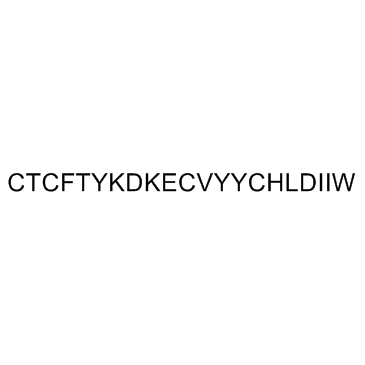Endothelin-3 (human, mouse, rabbit, rat) acetate salt

Endothelin-3 (human, mouse, rabbit, rat) acetate salt structure
|
Common Name | Endothelin-3 (human, mouse, rabbit, rat) acetate salt | ||
|---|---|---|---|---|
| CAS Number | 117399-93-6 | Molecular Weight | 2643.04000 | |
| Density | N/A | Boiling Point | N/A | |
| Molecular Formula | C121H168N26O33S4 | Melting Point | N/A | |
| MSDS | USA | Flash Point | N/A | |
Use of Endothelin-3 (human, mouse, rabbit, rat) acetate saltEndothelin-3, human, mouse, rabbit, rat is a 21-amino acid vasoactive peptide that binds to G-protein-linked transmembrane receptors, ET-RA and ET-RB. |
| Name | Endothelin 3 human, rat |
|---|---|
| Synonym | More Synonyms |
| Description | Endothelin-3, human, mouse, rabbit, rat is a 21-amino acid vasoactive peptide that binds to G-protein-linked transmembrane receptors, ET-RA and ET-RB. |
|---|---|
| Related Catalog | |
| Target |
ET-RA, ET-RB[1] |
| In Vitro | The endothelins (ETs) are a family of 21-amino-acid vasoconstrictor peptides comprising three distinct isoforms: ET-1, ET2 and Endothelin-3. Endothelin-3 is detected in plasma, heart, brain and vascular smooth muscle cells (VSMCs). The surface enzymes of VSMCs break down big Endothelin-3 to the corresponding mature peptide, Endothelin-3. Endothelin-3 down-regulate endothelin ETA receptor expression in coronary artery VSMCs without affecting receptor density or functional ETA receptor responses. By contrast, high concentrations of Endothelin-3 (100 nM) increase the expression of ETB receptors but abolish the vasoconstrictor response of the receptors, possibly due to the desensitizing effect of Endothelin-3[1]. Endothelin-3 stimulates ENCC adhesion to various ECM components. Endothelin-3 induces rapid changes in ENCC shape and protrusion dynamics favouring sustained growth and stabilization of lamellipodia, a process coincident with the increase in the number of focal adhesions and activated β1-integrins[2]. |
| In Vivo | Endothelin-3 at low concentrations may attenuate inflammatory responses via ETB2 activation and NO production. Endothelin-3, which acts mainly on ETB, at low concentrations specifically inhibited platelet-activating factor (PAF)-induced paw oedema, whereas neither ET-1 nor Endothelin-2, both of which act on ETA and ETB, showed inhibitory activity. The inhibition by ET-1 and Endothelin-3 (each 0.5 pmol/paw) in the presence of BQ-123 (66.4 ± 6.7 % and 65.4 ± 22.6 %, respectively), is comparable to that by Endothelin-3 (0.5 pmol/paw) alone (65.4 ± 10.9 %), whereas neither ET-1 nor Endothelin-3 in the presence of BQ-788 showed inhibitory activity[3]. |
| References |
| Molecular Formula | C121H168N26O33S4 |
|---|---|
| Molecular Weight | 2643.04000 |
| Exact Mass | 2641.11000 |
| PSA | 1056.08000 |
| LogP | 6.33930 |
| Appearance of Characters | powder | white |
| Storage condition | −20°C |
| Safety Phrases | S22 |
|---|---|
| RIDADR | NONH for all modes of transport |
| WGK Germany | 3 |
|
Involvement of endothelins in deoxycorticosterone acetate-salt hypertension through the modulation of noradrenergic transmission in the rat posterior hypothalamus.
Exp. Physiol. 100 , 617-27, (2015) What is the central question of this study? Does ex vivo administration of endothelin-1 and endothelin-3 regulate noradrenergic transmission in the posterior hypothalamus of deoxycorticosterone acetat... |
|
|
Direct conversion of mouse and human fibroblasts to functional melanocytes by defined factors.
Nat. Commun. 5 , 5807, (2014) Direct reprogramming provides a fundamentally new approach for the generation of patient-specific cells. Here, by screening a pool of candidate transcription factors, we identify that a combination of... |
|
|
Analysis of immunostaining and western blotting of endothelin 1 and its receptors in mitral stenosis.
Rev. Bras. Cir. Cardiovasc. 30 , 211-8, (2015) Rheumatic Fever represents a serious public health problem in developing countries, with thousands of new cases each year. It is an autoimmune disease, which occurs in response to infection by strepto... |
| ET-3 |
| MFCD00076378 |
| Endothelin 3 human,rat |
| Endothelin-3, human |
| Endothelin-3, human, mouse, rabbit, rat |

